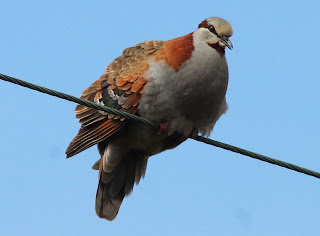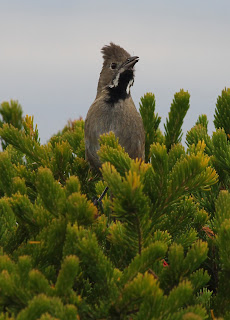Tuesday, 17th December found me on a Qantas flight to Perth and then a Virgin Australia flight to Albany, in the SW corner of the continent. Targets .... Western Bristlebird, Western Whipbird, Western (Rufous) Fieldwren, Noisy Scrub-bird and Carnaby's Black Cockatoo. Excited, anxious and dead-set keen to get birding, I was met by the laconic welcome of Peter John Taylor, birder extra-ordniaire (Birding South-West) and all-round nice guy, who collected me from the airport and away we went - straight to Cheyne's Beach and hopefully four of the five potential lifers.
70 kilometres later we arrived at Cheyne's Beach, to be greeted by hundreds of Tree Martins, who were happily basking on the bitumen (tarmac) road, and the "hoom" of both Common and Brush Bronzewings. Normally both of these pigeons are fairly skittish around humans, but not at Cheyne's Beach - they were happily perched out in the open, calling merrily and allowing for close up viewing.
Brush Bronzewing
Having booked into the caravan park, Pete and I headed down to the coastal scrub in the late afternoon to start the hunt. A few minutes later, a flock of Carnaby's Black Cockatoos descended on the scrub and started to munch on the banksia bushes. 597! A celebratory "high five" took place. One down, four to go.
Carnaby's Black Cockatoo
We also had Purple-crowned Lorikeets and Elegant Parrots sweep across the sky above us. From the bushes Pete could hear Western Bristlebirds calling, but he said we needed to head down to the scrub by the foreshore because it was time for the Noisy Scrub-birds. "Time for what?", I thought.
Purple-crowned Lorikeets
At 6:18pm Pete came to attention and motioned to the right hand side of the track. I spotted some movement amongst the undergrowth. Suddenly a Scrub-bird appeared and then nipped back into the bush. I had enough time to get a view through the binoculars and confirm it's identity and then it disappeared momentarily. I grabbed my camera, waiting for a shot. And then, ZIP - this ball of feathers erupted form the scrub and ran like the road-runner across the track. Absolutely no chance of a photo. GONE! I turned to Pete who was looking strangely pleased and I said something like, "Is that it?!" Pete just looked at me. Then he replied, "That was a great view! Most people don't even get that much!".
We settled in to wait again. At 6:32pm (I gathered that it was important to keep time of Noisy Scrub-bird appearances), there was more movement near the edge of the track. This time I had my camera ready. A Scrub-bird briefly appeared, I took the world's worst photo, and then, ZIP - it was across the track and gone. A little crest-fallen I decided not to look at Pete. I knew that spotting two Scrub-birds in one evening was going to be feted. It was only then that I realised that two other birders hovering in the general vicinity didn't see either of them, so I gradually warmed to our success and notched my belt - 598! The obigatory "high five" was shared.
(My invaluable contribution to the collection of photos of Noisy Scrub-birds!!)
Pete and I headed back to our cabin, where the staff appeared with straight-from-the-oven-lasagna and salad. We washed it down with a very nice local "red" and I collapsed into bed at about 9:00pm. I had been up since 2:30am (Perth time), and Pete wanted us up at 5:00am to chase down Bristlebirds and Whipbirds. 24 species seen and the promise of lots more the next day. I fell to sleep as I fell on the bed.
Early the next morning Pete asked me whether I had heard the Southern Boobook during the night. Dead people don't hear things. By 5:00am we were on our way. We headed away from the beach into the coastal scrub and very soon heard a Western Whipbird calling. We closed in and waited, peering into the thick foliage. Finally we saw some movement, and then the bird moveed momentarily into a gap and I was able to get a great view through my binoculars. No hope of a photo, but I was "stoked"! I had searched aimlessly on many occasions to find this bird in the Innes National Park in South Australia, so to get a really good look of a long term "hit-list" bird was very pleasing. Skulker number two ticked off. 599 now seen! A happy high-five was celebrated.
And my hands began twitching! Surely, the next bird was going to be a challenge, I thought. 600 won't be so easy, I reasoned. Finding Bristlebirds, another skulker, is very unpredictable I was told by Pete. "Don't get too excited Mike", I told myself. We turned and began to head further along the sandy track we had been following. And a Western Bristlebird casually walked onto the track in front of us. JOY!! Not content to just show itself, it then sat on a spindly stick right in front of us and began to sing! AWESOME! Pete whipped his camera out too and we snapped happily away! 600!! And it was only 5:30am! I fleetingly thought of giving Pete a hug, but wisely chose an effusive "high-five" instead. All three skulkers seen. Four out of the five targets spotted. Brilliant!
Western Bristlebird
Once I had calmed down, we decided to head back for some breakfast and then drive to the Stirling Ranges to track down the Western (formerly Rufous) Fieldwren. Soon we were in the car heading inland. Along the way we added to our overall total, including the WA race of Yellow-thoated Miners, which may well be split from their close cousins in eastern Australia.
Yellow-throated Miner
We eventually reached the ranges, parked the car and headed to Pete's "Secret GPS Spot" for Fieldwrens.............. Nothing. We ventured further in. NIX. We traversed a dirt track. ZILCH. After about an hour of nothing but Tawny-crowned Honeyeaters, who refused to stay still long enough to photograph, we trudged quietly back towards the car. As we reached Pete's "Secret GPS Spot" once more, we heard a Fieldwren call. Scouring the bush, we quickly found it, sitting happily in the open having a lovely sing-a-long. Unlike the Honeyeaters, this little chap was more than happy to pose for photos and so I was able to get a great shot of it. And that was that! It wasn't even lunch and I had seen all five of my targets! 601! Very cool indeed!! Pete and I "high-fived" and then looked at each other and thought, "Now what?"
Western (Rufous) Fieldwren
Plan B was enacted - head to Albany and check the local wetlands for photo opportunities. After indulging in a CHIKO roll and some chips covered in salt and vinegar for lunch, we spent the afternoon at Lake Seppings, and what a fantastic place this is! Within minutes of starting a walk around the lake I had awesome views of a wide variety of both water birds and bush birds, with many stopping by for a photo shoot. Red-winged Fairy-wren, Western Gerygone, Sacred Kingfisher, Blue-billed and Musk Ducks, and, eventually, Red-eared Firetails along with a many other species. The light was perfect and I was thrilled with the photo opportunities.
Blue-billed Duck
Musk Duck
Red-winged Fairy-wren (female)
Red-winged Fairy-wren (male)
Red-eared Firetail
Western Gerygone
Sacred Kingfisher
Eventually we headed off, arriving back at Cheyne's Beach, hoping to see another view of the Noisy Scrub-bird. We head one calling, but none put in an appearance, reminding me of how well we had actually done the evening before. A delicious chicken curry was served for dinner, and after a brief count of our total - 84, with 5 lifers for Mike (happy boy!), we headed to bed.
We awoke early the next morning with one aim, to photograph a Western Whipbird. We headed out into the coastal scrub bouyant from our success of the last two days. After two and a half hours ... nothing. I hadn't taken a photo of anything, let alone a Whipbird. We had heard one call but it was so far away it was not worth chasing. Having done an enormous loop of the scrub, we wandered back down towards the caravan park, when we suddenly heard a Whipbird very close. Just then, one flew passed us, and another one started calling as well. A pair! We spent the next fifteen minutes quietly tracking them, but they remained very elusive, calling from deep within the scrub, but not showing themselves. They then found a particular bush they especially liked and called happily away to each other, so we waited. And then, without warning, one of them popped up on top of the bush and sang it's heart out! And my camera went into over-drive!! Very, very cool indeed.

Western Whipbird
We then headed back for breakfast but the bush came alive. I snapped Red-capped Parrot, White-breasted Robin, Western Spinebill (female) and a Western Wattlebird (all endemics to SW Western Australia). What a great way to end my time at Cheyne's Beach!
Red-capped Parrot
White-breasted Robin
Western Spinebill (female)
Western Wattlebird
Pete and I hurried back for breakfast, packed up and headed for the airport. I cannot thank Pete enough for his birding, his knowledge and his company. He really knows his stuff and I would recommend him to everyone. I jumped on the plane, absolutely thrilled with my "mad" decision to "dash" to WA, a three hour plane flight from Adelaide. It was worth every cent. 601 species for OZ, 81 species for the two days, and 5 lifers, along with some really pleasing photographs.
Another Excellent Bird Adventure for Pots. (Note contented sigh!)
Birds Seen
- Musk Duck
- Black Swan
- Australian Shelduck
- Australian Wood Duck
- Grey Teal
- Northern Mallard
- Pacific Black Duck
- Blue-billed Duck
- Hoary-headed Grebe
- Great Crested Grebe
- Common Bronzewing
- Brush Bronzewing
- Crested Pigeon
- Little Pied Cormorant
- Great Cormorant
- Little Black Cormorant
- Australian Pelican
- White-necked Heron
- White-faced Heron
- Australian White Ibis
- Straw-necked Ibis
- Yellow-billed Spoonbill
- Whistling Kite
- Swamp Harrier
- Wedge-tailed Eagle
- Nankeen Kestrel
- Brown Falcon
- Purple Swamphen
- Dusky Moorhen
- Eurasian Coot
- Common Greenshank
- Crested Tern
- Pacific Gull
- Silver Gull
- Carnaby's Black Cockatoo *
- Galah
- Purple-crowned Lorikeet
- Regent Parrot
- Australian Ringneck
- Red-capped Parrot
- Elegant Parrot
- Laughing Kookaburra
- Sacred Kingfisher
- Noisy Scrub-bird *
- Splendid Fairy-wren
- Red-winged Fairy-wren
- Southern Emu-wren
- Western Bristlebird *
- White-browed Scrub-wren
- Western Fieldwren *
- Western Gerygone
- Inland Thornbill
- Western Spinebill
- Yellow-throated Miner
- Western Wattlebird
- Red Wattlebird
- Tawny-crowned Honeyeater
- Brown Honeyeater
- New Holland Honeyeater
- White-cheeked Honeyeater
- Western Whipbird *
- Black-faced Cuckoo-Shrike
- White-winged Triller
- Golden Whistler
- Black-faced Woodswallow
- Grey Butcherbird
- Australian Magpie
- Grey Currawong
- Grey Fantail
- Willie Wagtail
- Australian Raven
- Magpie Lark
- White-breasted Robin
- Australian Reed-warbler
- Rufous Songlark
- Brown Songlark
- Silvereye
- Welcome Swallow
- Tree Martin
- Red-eared Firetail
- Australian Pipit





.jpg)



.jpg)







.jpg)

Great photos and report Mike and congrats on passing 600! I'll be down that way early in the New Year and hoping to find some of those endemics. What's the best way to get in touch with Pete?
ReplyDeleteHi John. Thanks mate. You can contact Pete through "Birding South West". I hope you have as good a time as I did. Pete is fantastic.
Delete